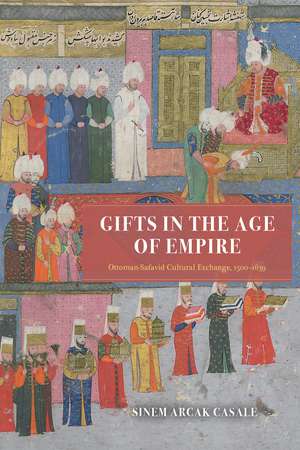Gifts in the Age of Empire: Ottoman-Safavid Cultural Exchange, 1500–1639: Silk Roads
Autor Sinem Arcak Casaleen Limba Engleză Hardback – 7 sep 2023
When the Safavid dynasty, founded in 1501, built a state that championed Iranian identity and Twelver Shi'ism, it prompted the more established Ottoman Empire to align itself definitively with Sunni legalism. The political, religious, and military conflicts that arose have since been widely studied, but little attention has been paid to their diplomatic relationship. Sinem Arcak Casale here sets out to explore these two major Muslim empires through a surprising lens: gifts. Countless treasures—such as intricate carpets, gilded silver cups, and ivory-tusk knives—flowed from the Safavid to the Ottoman Empire throughout the sixteenth century. While only a handful now survive, records of these gifts exist in court chronicles, treasury records, poems, epistolary documents, ambassadorial reports, and travel narratives. Tracing this elaborate archive, Casale treats gifts as representative of the complicated Ottoman-Safavid coexistence, demonstrating how their rivalry was shaped as much by culture and aesthetics as it was by religious or military conflict. Gifts in the Age of Empire explores how gifts were no mere accessories to diplomacy but functioned as a mechanism of competitive interaction between these early modern Muslim courts.
Preț: 375.55 lei
Nou
Puncte Express: 563
Preț estimativ în valută:
71.86€ • 75.37$ • 59.82£
71.86€ • 75.37$ • 59.82£
Carte disponibilă
Livrare economică 11-25 martie
Livrare express 25 februarie-01 martie pentru 70.01 lei
Preluare comenzi: 021 569.72.76
Specificații
ISBN-13: 9780226820422
ISBN-10: 0226820424
Pagini: 288
Ilustrații: 108 color plates
Dimensiuni: 178 x 254 x 28 mm
Greutate: 1.25 kg
Ediția:First Edition
Editura: University of Chicago Press
Colecția University of Chicago Press
Seria Silk Roads
ISBN-10: 0226820424
Pagini: 288
Ilustrații: 108 color plates
Dimensiuni: 178 x 254 x 28 mm
Greutate: 1.25 kg
Ediția:First Edition
Editura: University of Chicago Press
Colecția University of Chicago Press
Seria Silk Roads
Notă biografică
Sinem Arcak Casale is associate professor of Islamic art at the University of Minnesota.
Cuprins
Note on Transliteration
Introduction
1 Scandal and Decorum
2 An Exquisite Shahnama
3 King of the World
4 Little Prince Bearing Gifts
5 Diplomacy and Transaction
Epilogue
Appendix 1: Favors to Ahmed Beg, July 1505
Appendix 2: Remittance to Shaikh Ismaʿil, November 1510
Appendix 3: Gifts to Selim II, 1568
Appendix 4: Gifts to Murad III, January 1590
Appendix 5: Favors to Haydar Mirza, January 1590
Appendix 6: Gifts to Mehmed III, January 1597
Acknowledgments
Notes
Bibliography
Index
Introduction
1 Scandal and Decorum
2 An Exquisite Shahnama
3 King of the World
4 Little Prince Bearing Gifts
5 Diplomacy and Transaction
Epilogue
Appendix 1: Favors to Ahmed Beg, July 1505
Appendix 2: Remittance to Shaikh Ismaʿil, November 1510
Appendix 3: Gifts to Selim II, 1568
Appendix 4: Gifts to Murad III, January 1590
Appendix 5: Favors to Haydar Mirza, January 1590
Appendix 6: Gifts to Mehmed III, January 1597
Acknowledgments
Notes
Bibliography
Index
Recenzii
“Focusing on primary sources, Casale extensively contextualizes the gift exchanges between the Safavids and Ottomans in the early sixteenth-century within their cultural and historical context. With clear writing and fresh perspectives, Gifts in the Age of Empire is a bold book that will particularly interest art historians, cultural historians, and scholars interested in material culture and materiality.”
“Until now, viewing early modern Ottoman and Safavid art and politics through the lens of gift giving was a relatively novel idea and one that had not previously been employed in a comprehensive manner. With Gifts in the Age of Empire, Casale repositions the study of gift exchange in a broader sphere, which has to do with the global movement of works of art and its impact on visual culture. This thoroughly researched, well-written, and profusely illustrated monograph is particularly relevant when considering later Islamic arts.”




